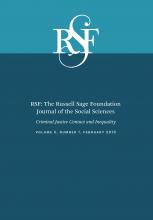Research Article
Open Access
Digital Vulnerability: The Unequal Risk of E-Contact with the Criminal Justice System
Robert Vargas, Kayla Preito-Hodge, Jeremy Christofferson
RSF: The Russell Sage Foundation Journal of the Social Sciences February 2019, 5 (1) 71-88; DOI: https://doi.org/10.7758/RSF.2019.5.1.04
Robert Vargas
aNeubauer Family Assistant Professor of Sociology and director of the Violence, Law, and Politics Lab at the University of Chicago.
Kayla Preito-Hodge
bA graduate student in the sociology department at the University of Massachusetts-Amherst and a recipient of the National Science Foundation’s Graduate Research Fellowship.
Jeremy Christofferson
cA graduate student in the sociology department at the University of Notre Dame.

REFERENCES
- ↵
- Asher, Jeff, and
- Rob Arthur
- ↵
- Brayne, Sarah
- ↵
- Brayne, Sarah
- Chicago Crime Commission
- City of Chicago Data Portal
- ↵
- City of Chicago Radio Communications
- ↵
- Davis, Julie
- ↵
- ↵
- Federal Bureau of Investigation
- ↵
- Federal Communications Commission
- ↵
- Fineman, Martha Albertson
- ↵
- Gambetta, Diego
- ↵
- Hagedorn, John
- ↵
- Hudson, Travis
- ↵
- Jacobs, James B
- ↵
- Jacobs, Bruce A., and
- Richard Wright
- ↵
- ↵
- Klinger, David A
- ↵
- Kunichoff, Yana
- ↵
- ↵
- ↵
- Manza, Jeff, and
- Christopher Uggen
- ↵
- ↵
- ↵
- ↵
- Paquette, Danielle
- ↵
- Patrick, Robert
- ↵
- ↵
- Preusse, Kimberly C., and
- Christina Gipson
- ↵
- Sanchez-Jankowski, Martin
- ↵
- Sargent, Jordan
- ↵
- Serrato, Jacqueline
- ↵
- Sewell, Abigail A., and
- Kevin A. Jefferson
- ↵
- Shane, Scott,
- Nicole Perloth, and
- David E. Sanger
- ↵
- Soss, Joe,
- Richard C. Fording, and
- Sanford Schram
- ↵
- Stuart, Forrest
- ↵
- ↵
- Sugie, Naomi F., and
- Kristin Turney
- ↵
- ↵
- U.S. Census Bureau
- ↵
- Van Cleve,
- Nicole Gonzalez
- ↵
- Vargas, Robert
- ↵
- Venkatesh, Sudhir Alladi
- ↵
- Vuolo, Mike,
- Sarah Lageson, and
- Chris Uggen
- ↵
- Wakefield, Sara, and
- Christopher Wildeman
In this issue
Digital Vulnerability: The Unequal Risk of E-Contact with the Criminal Justice System
Robert Vargas, Kayla Preito-Hodge, Jeremy Christofferson
RSF: The Russell Sage Foundation Journal of the Social Sciences Feb 2019, 5 (1) 71-88; DOI: 10.7758/RSF.2019.5.1.04
Jump to section
Related Articles
- No related articles found.
Cited By...
- No citing articles found.





